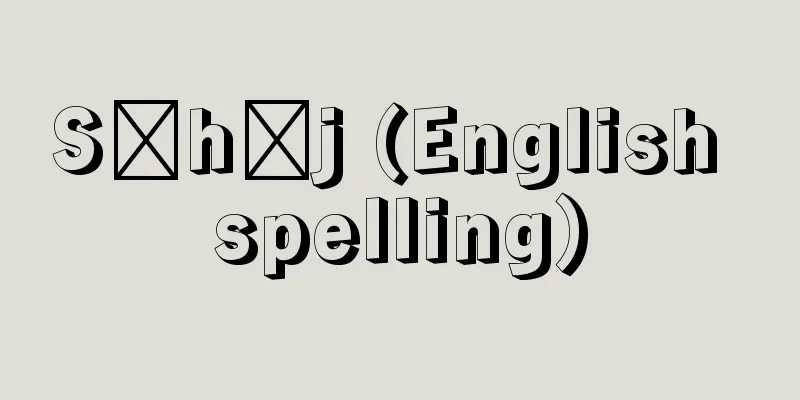Fubok Wakasho - Fubok Wakasho

|
A privately compiled anthology of poems on a similar theme from the late Kamakura period. It is also called "Fuki Wakashu" and abbreviated as "Fuki Sho" or "Fuki Shu." The editor was Fujiwara (Katsuta) Nagakiyo, a disciple of Reizei Tamesuke and a powerful lord in Totomi Katsumata (present-day Makinohara City, Shizuoka Prefecture). In the collection, there is a poem by Tamesuke: "I came to visit, and as I saw it, the shadow of Katsumata's flowers was rising." It was probably compiled around 1310 (Enkei 3). The motivation for compiling it may have been related to the fact that Tamesuke, along with Tameyo and Tamekane, wanted to be the editor of an imperial anthology when selecting the "Gyokuyo Wakashu." This huge collection of poems contains over 17,000 poems from the Manyo period to the present day that were not, as a rule, included in imperial anthologies, and is divided into 36 volumes, 18 of each for the four seasons and miscellaneous, and about 600 themes (from "The Beginning of Spring in the Year" to "Recollections"), by about 970 poets. There are many poems with unusual themes, such as poems with free grammar by Sone Yoshitada, Minamoto Toshiyori, and Saigyo, and Jakuren's "100 Poems on 10 Themes" (about plants and animals), and the sections on "Mountains" and "Seki" have utamakura (poems) arranged in alphabetical order, which made them highly valued by later poets and linked verse masters. However, there are many typos and irregularities in the text of the extant edition. The title is said to be a simplified painting of "Fuso". [Shuichi Fukuda] ``Author Classification of Ogi Wakasho, Main Text Edition'' by Kiyoshi Yamada and Seiji Ogano (1967, Kazama Shobo) ▽ ▽ ``Author Classification of Ogi Wakasho, Research Index Edition'' by Kiyoshi Yamada (1970, Kazama Shobo) ▽ ``Hideichi Fukuda's ``Obuki Sho'' (edited by Waka Literature Association, ``Waka Literature Course 4' ') Included in Manyoshu and Imperial Selected Wakashu, 1970, Ohkaedesha) Source: Shogakukan Encyclopedia Nipponica About Encyclopedia Nipponica Information | Legend |
|
鎌倉後期の私撰(しせん)類題和歌集。『夫木和歌集』ともいい、「夫木抄」または「夫木集」とも略称する。撰者は冷泉為相(れいぜいためすけ)の門弟で遠江勝田(とおとうみかつまた)(現静岡県牧之原(まきのはら)市)の豪族藤原(勝田)長清。集中に為相の「尋ね来てかつ見るからにかつまたの花の陰こそ立ちうかりけれ」の詠がある。1310年(延慶3)ごろ成立か。編纂(へんさん)の動機は、『玉葉和歌集』撰定の際に、為世(ためよ)や為兼(ためかね)と並んで為相も勅撰集の撰者を望んだことと関係があろう。万葉以来当代までの歌で原則として勅撰集に入らなかった1万7000余首を四季・雑各18巻計36巻、約600の題(「歳内立春」以下「述懐」まで)に部類した膨大な歌集で、採録の歌人は約970名に及ぶ。曽禰好忠(そねのよしただ)・源俊頼(としより)・西行(さいぎょう)らの自由な語法の歌や寂蓮(じゃくれん)の「十題百首」(動植物を詠む)など珍しい題材の歌も多く、「山」「関」などの部はいろは順に歌枕(うたまくら)が並んでいるなど、後世歌人や連歌(れんが)師に珍重された。ただ伝本の本文に誤字や乱れが多い。題名は「扶桑(ふそう)」の省画という。 [福田秀一] 『山田清市・小鹿野清次著『作者分類夫木和歌抄 本文篇』(1967・風間書房)』▽『山田清市著『作者分類夫木和歌抄 研究索引篇』(1970・風間書房)』▽『福田秀一『夫木抄』(和歌文学会編『和歌文学講座4 万葉集と勅撰和歌集』所収・1970・桜楓社)』 出典 小学館 日本大百科全書(ニッポニカ)日本大百科全書(ニッポニカ)について 情報 | 凡例 |
Recommend
Adrenergic neuron
… Adrenaline does not pass through the blood-brai...
Kasugamycin
C 14 H 25 N 3 O 9 (379.37). An aminoglycoside ant...
Aitken nuclei
Aerosol particles with diameters ranging from 2nm ...
Moonflower Passion - Gekkayojo
A humorous story. One volume. Written by the owner...
dotted print
…Relief printing is an exception, being limited t...
Action française (English spelling)
A French nationalist political group formed in the...
Anorthite - anorthite
Anorthite is one of the six types of plagioclase,...
taxes on knowledge
…In the 18th century, conservative forces were st...
Moravia (English spelling) Moravia, Alberto
Born: November 28, 1907 in Rome [Died] September 2...
Callistus II
…the treaty between Holy Roman Emperor Henry V an...
Shantou
A prefecture-level city on the South China Sea in...
Tarsier (spectacled monkey) - Tarsier (English spelling)
A general term for the prosimians of the Tarsiidae...
Takeo Miki
Politician. Born March 17, 1907 in Yoshida, Gosho...
Giraffe - giraffe (English spelling)
An animal of the order Giraffidae, order Artiodac...
Tipula aino (English: Tipula aino)
An insect of the Diptera family, Crane Fly (illust...



![Titicaca [Lake] - Titicaca](/upload/images/67cc2e402f50e.webp)





